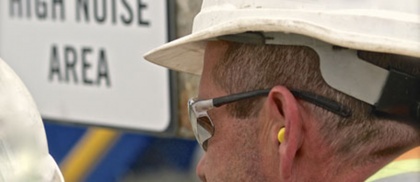A Primer on Hearing Protection

Hearing Protection
One form of controlling noise hazards is through the proper use of hearing protection devices (HPDs). Hearing protectors should be provided when engineering controls cannot be implemented or while such controls are being initiated.
Hearing protective devices are barriers that reduce the amount of noise reaching the sensitive inner ear. Fit, comfort, and sound reduction or “attenuation” are important considerations in choosing HPDs.
Commonly used hearing protection devices are either earplugs or earmuffs. Earplugs attenuate noise by plugging the ear canal. The muff-type protector is designed to cover the external part of the ear providing an “acoustical seal”.
Effectiveness
Obviously, the effectiveness of an HPD depends on the amount of time it is worn. What is not obvious to most wearers is the drastic reduction in protection if HPDs are not worn in noise environments even for short periods of time.
The reduction in effectiveness can be as great as 95% or more if the protectors are not worn for as little as three or four minutes. It is therefore important to wear HPDs during the entire noise exposure period in order to achieve the maximum protection available.
The effectiveness of HPDS also depends on the manner in which noise is transmitted through or around the protector. The following points should be noted.
- Even relatively small openings or air leaks in the seal between the hearing protector and the skin can typically reduce attenuation by 5 to 15 dB or more.
- Constant movement of the head or body vibration can lead to air leaks, therefor making periodic adjustments necessary to ensure a proper seal.
- Hair, especially long hair and facial hair, can cause a poor fit.
- Proper fitting is crucial to obtaining a reasonable degree of protection from an HPD.
- Earmuff effectiveness is greatly influenced by headband tension. If tension decreases through routine usage or alteration by the user, earmuff effectiveness is reduced.
- Modifying the earmuff by drilling holes in the earcups renders the protection useless.
- Anatomical differences such as ear canal size, jaw size, and heads of different shape and size may affect the fit of earmuffs and earplugs. To accommodate these differences, HPDs should be made available to users in various shapes and sizes.
- Recreational headsets such as those used with radios and CD players are not to be used as hearing devices.
Based on Files from the Infrastructure Health & Safety Association: Construction Health and Safety Manual 2013 Edition